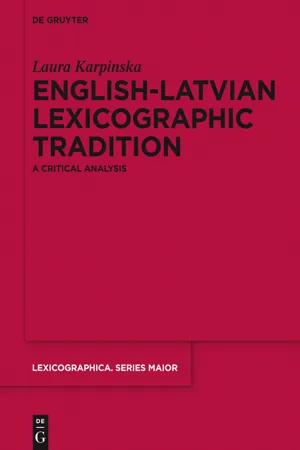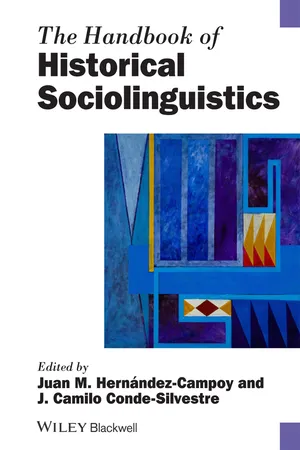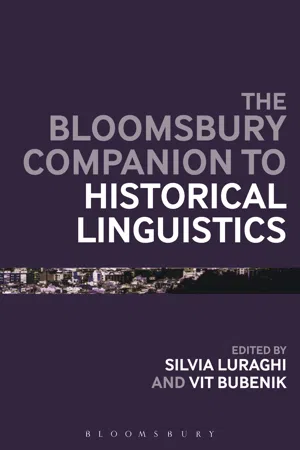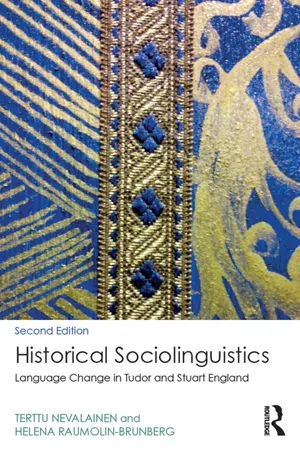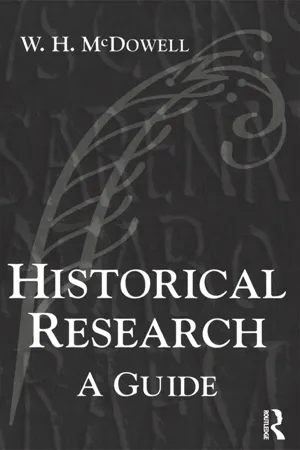Languages & Linguistics
Primary Source
A primary source in the field of languages and linguistics refers to original documents or artifacts that provide firsthand evidence of a particular topic or event. These sources are created at the time of the event or by individuals who directly experienced or witnessed it. Examples of primary sources in linguistics include historical texts, original manuscripts, and recordings of native speakers.
Written by Perlego with AI-assistance
Related key terms
Related key terms
1 of 4
Related key terms
1 of 3
5 Key excerpts on "Primary Source"
- eBook - ePub
- Laura Karpinska(Author)
- 2015(Publication Date)
- De Gruyter(Publisher)
3 Primary and secondary sources of evidence in bilingual lexicography
The quality and reliability of a dictionary largely depends on its sources or the lexicographic evidence it is based on (Atkins and Rundell 2008 : 46). There are two basic types of dictionary sources – primary (original linguistic material) and secondary (derivative material). Primary Sources can be citation files, corpora, fieldwork and introspection, while other dictionaries, encyclopaedias and grammars serve as secondary sources (e.g. Hartmann and James 2001 : 128; Čermák 2003 : 18–19; Svensén 2009 : 39–47).Although usually a particular type of information is selected as the basic source,it is possible that it proves to be insufficient, which results in a combination of sources (Hanks 1990 : 32; Hartmann and James 2001 : 128; Čermák 2003 : 18; Jackson 2002 : 28–29). Introspection, defined by Atkins and Rundell (2008 : 46) as “the process in which you give an account of a word and its meaning by consulting your own mental lexicon”, is an important and frequently applied source in practical lexicography; however, it has been noted by several scholars (e.g. Sinclair 1985 : 82; Hanks 1990 : 31–32; Ooi 1998 : 47–48; Atkins and Rundell 2008 : 46–47; Atkins 2008 : 271) that in lexicography judgements cannot be based purely and primarily on introspection because in comparison with other authentic data (e.g. from corpora, citation files) it does not give access to how the language is really used by the linguistic community. Another reason why a dictionary based on introspection only would be unreliable, lies in the fact that “one individual’s store of linguistic knowledge is inevitably incomplete and idiosyncratic” (Atkins and Rundell 2008 - eBook - ePub
- Juan Manuel Hernández-Campoy, Juan Camilo Conde-Silvestre(Authors)
- 2012(Publication Date)
- Wiley-Blackwell(Publisher)
In sociolinguistics, the gathering of data relies mainly on everyday language: with methodological tools such as interviews, participant observation, and telephone surveys, spoken records are easily obtained. For the historical sociolinguist studying early stages of the language this is impossible, since the oral performance of speakers is not available and written documents are the only source of information. This problem is shared by scholars working in other subdisciplines and approaches within linguistics, especially by historical linguists, for whom the retrieval of language depends on written records preserved over time. These groups have a common interest in assembling solid data, assessing sources, surveying style levels, ascertaining the role of editing, and trying to approach speech as thoroughly as possible. They share the difficulty of dealing with considerable chronological gaps in extant material of different periods (Schneider 2002: 68), although there are differences between them in, for example, methods, interests, and goals.This chapter sets out to survey different types of written documents and to examine their validity for historical sociolinguistic research. Language variation and change, and the circumstances in which they occur, can help us understand historical events and these linguistic phenomena, in turn, can also be interpreted by means of historically attested developments. Taking the tools employed by sociolinguistics for contemporary languages and applying them to the past enables the historical reconstruction of language in its social context (Conde-Silvestre 2007: 10–34).1 For this purpose, dialectal diversity and divergent developments must be included in historical language description, as this projection of linguistic variability onto the past is what differentiates sociolinguistic approaches from traditional ones (Milroy 1992: 52). The historical texts that can be useful for sociolinguistic analysis are varied; here, medical, official, and monastic documents will be examined. One of the main tenets of the discipline is that linguistic evidence rendered by written sources can be related to extralinguistic parameters, thus delivering insights into the sociohistorical state of the participants involved in the act of communication which a specific text presupposes. Sometimes, especially in early historical periods, material elements are accessible as well as linguistic data and, if possible, should also be considered. Accordingly, the relationship between the manuscript or book and the text should not be forgotten, given that the former can be viewed from a range of perspectives and can provide invaluable information about the manner of transmission, copies, translations, or commentaries of the text, as well as background on its purpose or function. Examining all the aspects that relate to the making (date, place, scribe) and decoration of manuscripts and early books,2 - Silvia Luraghi, Vit Bubenik(Authors)
- 2013(Publication Date)
- Bloomsbury Academic(Publisher)
Historical Syntax in Cross-Linguistic Perspective (1995) by Alice C.Harris and Lyle Cambell who moved the field closer to explicating the range and nature of causes of syntactic change (reanalysis, extension, and language contact and syntactic borrowing) combining historical linguistics with recent advances in linguistic typology. In 1973 the series of International Conferences on Historical Linguistics began, which bring together biennially leading scholars in the field. Much of their scholarship can be found in the following chapters of this book.2. SourcesHistorical research requires some time depth; consequently, it mainly focuses on language families which rely on a long documented time span. Among the world’s languages, those that are documented for longer than two thousand years are Indo-European, Afro-Asiatic and Sino-Tibetan. A number of other language families, such as Uralic, Altaic, Caucasian, Dravidian, Austronesian and Japanese are documented to different extents starting from the first half of the first millennium ce; most language families, however, are known only from data from the second millennium CE . Ancient documentation also includes a number of extinct languages, such as Sumerian (third–second millennium bce) or Etruscan (first millennium bce), both isolate, which have been in contact with some Indo-European and Afro-Asiatic languages.When no direct sources are available, some insight into an otherwise unknown language may still be gained through indirect sources. They include evidence from borrowing, onomastics, toponomastics, words quoted in texts written in other languages. For example, the Celtic languages spoken in continental Europe are poorly documented in antiquity, via inscriptions (in several varieties: Gaulish, Celtiberian; some come even from the Balkans), but we can form some more ideas about them on the basis of anthroponyms and toponyms found in texts by Roman authors.2.1 Types of Source and Types of Writing SupportFor original sources to have been able to survive for centuries or millennia, the type of support must obviously be long lasting. Such are epigraphic sources, available for many early attested languages. Other relatively stable types of support are clay or metal artifacts, seals, shells or bones. The earliest Chinese texts are written almost exclusively on such supports: the earliest stages of Old Chinese are documented by the so-called oracle bones as well as by inscriptions on bronze.- eBook - ePub
Historical Sociolinguistics
Language Change in Tudor and Stuart England
- Terttu Nevalainen, Helena Raumolin-Brunberg(Authors)
- 2016(Publication Date)
- Routledge(Publisher)
Chapter 3 Primary Data: Background and Informants 3.1. Data in Historical Sociolinguistics 3.1.1. The ‘Bad-Data’ ProblemIt is true that researchers of the earlier varieties of a language cannot gather their data in the same way as a person studying present-day languages. The standard sociolinguistic methods, such as interview and elicitation, are automatically excluded. Recordings of spoken language are available only from the last century onwards. What serves as primary data necessarily represents written language and, as Labov says (1982: 20), ‘the fragments of the literary record that remain are the result of historical accidents beyond the control of the investigator’.In our experience, however, there is no need in historical linguistics to overstress what Labov calls ‘bad data’. True, historical data can be characterized as ‘bad’ in many ways, but we would rather place the emphasis on making the best use of the data available (Nevalainen 1999b). This requires systematicity in data collection, extensive background reading and good philological work, in other words, tasks that are demanding and timeconsuming but by no means unrealizable.Labov’s additional comment (1994: 11) that ‘[w]e usually know very little about the social position of the writers, and not much more about the social structure of the community’ seems to us rather inaccurate if not misleading, at least as far as the history of English is concerned. Extensive studies of how people lived in the past have been carried out by historians, from general investigations to research on particular areas and communities as well as families and individuals. Integrating information gathered by historians into linguistic research has been one of the challenges of this study.1 - eBook - ePub
Historical Research
A Guide for Writers of Dissertations, Theses, Articles and Books
- Bill Mcdowell(Author)
- 2013(Publication Date)
- Routledge(Publisher)
The authenticity and credibility of historical evidence can be an important consideration for many research projects. You may have to decide whether the content of a document, the author's signature or the date are accurate. It is reasonable to suppose that the contents of a document with a forged signature are also likely to be falsified. The content may not appear credible because the sequence of events is not in a proper chronological order. Information may also be at variance with factual evidence which you have been able to establish from other sources. The language, grammar, spelling, literary style, handwriting, typeface, type of ink or paper, or factual inaccuracies may all persuade you that source material may not be genuine. The location of a document, the envelope in which it was sent, or the circumstances in which it was discovered may also appear dubious. Evidence intended for a wide audience is probably more suspect than that intended for a restricted audience because unpleasant facts might have been concealed. We may also note that incorrect facts and interpretations may be mistakenly accepted because they appear to be consistent with existing knowledge, or because they are somehow inconvenient to believe. Problems can also arise if you discover that source material is missing, inconsistent or out of sequence. Moreover, particular care must be taken when examining statistical data, especially as this type of data can not only offer clarity and precision to ill-defined statements but can also mask individual errors within statistical averages. In any case, the use of statistical analysis to determine the probability of the occurrence of past events is problematical because in human affairs the chances that a sequence of events led to a given outcome is not as evenly balanced as throwing dice, where the probabilities can be calculated. When historians examine evidence they may be able to detect discrepancies between what is written and what is publicly known, but we should not be surprised if the occasional unusual, unexpected or coincidental event is in fact true. The information which follows will focus on the evaluation of primary and secondary source material, with particular emphasis on documentary and oral evidence because these form the basis of original historical research.Primary Sources: documents
One of the key categories of Primary Source material is documentary evidence. Few documents are important in their entirety, but they are a significant class of source material for historians. Some historical accounts are inevitably selective, since not all written records of past events are available. The reconstruction of past events needs to be based on an intelligent selection and interpretation of the best evidence which is available. An original contribution to a subject can be made by selecting relevant source material and providing a convincing analysis of the contents of this material. The quality of the data is more important than the type of source used, since even Primary Sources are likely to contain inaccurate or irrelevant information. Your historical work will contain both descriptive and analytical elements. You may pose new questions about old issues, or ask obvious questions about new themes and issues. What factors therefore should you bear in mind when examining documentary evidence?
Index pages curate the most relevant extracts from our library of academic textbooks. They’ve been created using an in-house natural language model (NLM), each adding context and meaning to key research topics.
Explore more topic indexes
Explore more topic indexes
1 of 6
Explore more topic indexes
1 of 4
